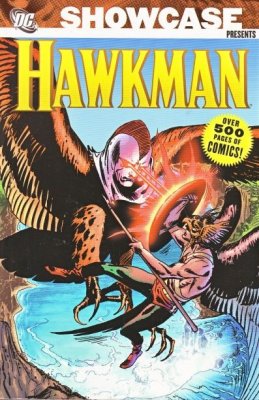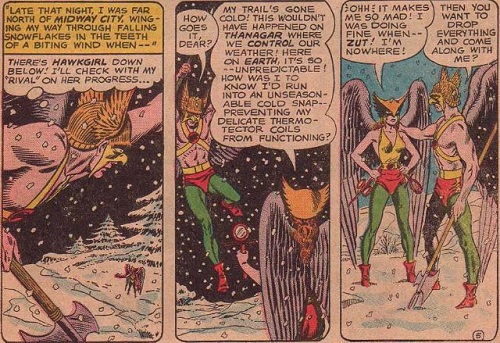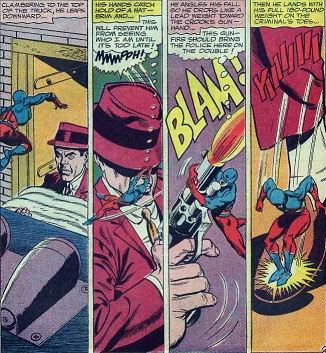
Showcase Presents: Hawkman, Volume 1
Gardner Fox, Joe Kubert, Murphy Anderson and friends
Reprints The Brave and the Bold #34-36, #42-44, 51, The Atom #7, Mystery in Space #87-90, Hawkman #1-11
Get this for: Great Kubert art, followed by somewhat bland Murphy Anderson art
This was a lot harder to get through than the Atom or The Flash volumes, because unlike them, this is much more of a grab bag of Hawkman appearances. Whereas the previous two heroes had a relatively straightforward path towards their own title, Hawkman went from several appearances in The Brave and the Bold, DC’s other tryout book, to a guest appearance in The Atom, a backup spot in Mystery in Space, as well as a teamup story with Aquaman back in The Brave and the Bold again and then only got his own title. Through all this save his Aquaman teamup his adventures were guided by Gardner Fox, also the Atom’s writer of course. He is his usual dependable self, though some of the later stories are on the formulaic side.
The real problem is in the art, which starts off very strong in his Brave and the Bold appearances. Joe Kubert had handled the Golden Age Hawkman and his expressive, scratchy, Noel Sickles/Alex Toth influenced art style is perfectly suited to the new series. It grounds the series, more so than the slicker, more sci-fi inspired artwork of Gil Kane or Carmine Infantino would’ve done. But he only does the art in Hawkman’s first six appearances. Once Hawkman gets his first series in Mystery in Space the art is handled by Murphy Anderson, whose art is both sleeker and blander than Kubert’s. Especially his characters are much less interesting than Kubert’s, who could do a lot with a simple look or expression.

The Golden Age Hawkman and Hawkgirl were reincarnations of an Egyptian prince and his lover and were solid second string heroes. They never had their own magazine, but had long runs in varius anthology series. As with other Silver Age heroes, Gardner Fox upgraded their origins to being alien police officers from the planet Thanagar, come to Earth to study our policing methods, choosing the USA’s Midway City to settle. I like the way in which they casually reveal themselves to the local police commissioner, who just as casually accepts their story and gets them cover identities working in Midway City’s museum, taking over from his brother who handily is going with retirement. Sometimes nepotism works. The museum also helps to inspire them to take up “the weapons of yesterday to fight the crimes of today”.

Those first six appearances, which I’ve read before, are the best stories in the volume and what I like the best about them is how equal Hawkman and Hawkgirl are as a team. There’s some unconscious sexist nonsense in there of course, starting with Hawkgirl’s name, not to mention the romantic triangle subplot with her, Hawkman and Mavis Trent, but on the whole Fox allows Hawkgirl to do her part even if Hawkman always has to be slightly better. As with other SA DC heroes, they have to use their heads as much as their fists, figuring out the gimmick of each story’s villain.
What’s new in these stories is the larger soap opera/continuity element compared to the first volumes I read. There’s Mavis Trent as a repeated foil, but there are also more appearances from other DC heroes: the teamups with Aquaman and the Atom, the crossover with Adam Strange, who also provides the origin for one recurring Hawkman villain, in general a greater awareness that there’s a larger universe outside their own stories. It’s nowhere near the Marvel level of course, but it’s welcome.

Less welcome is the change in artists. Murphy Anderson, though better known as an inker than a penciler, is certainly not a bad artist, is no match for Kubert. His figures are stiffer, his characters more bland, it’s closer to DC’s unofficial house style as seen in the Superman titles. It made the last half of the book much less interesting to read. I’m not sure why Kubert left the Hawks, but I wish he had stayed on.


